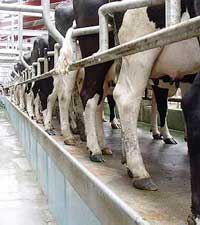Watch cow body language and lift performance

Dairy farmers who learn to read their cows’ body language could improve herd performance by up to 500 litres a head.
Dutch vet and cow behaviour expert, Joep Driessen, encourages farmers to be aware of key physical signs in their cows, including empty rumens.
Awareness of these and a focus on the essential needs of food, water, air, light, rest and space, can increase production and reduce costs.
Farmers spend a lot of time on the micro detail of improving milk production, such as adding yeast to feed, when making common sense changes to housing and feeding regimes would be more effective, says Mr Driessen.
“A cow should eat, drink and rest and not be standing around in the collecting yard for more than two hours a day. Everything else she does is a waste of time and money,” Mr Driessen suggests.
“The whole concept is based on common sense and nature. It’s just a matter of assessing cow behaviour through posture and other physical signs. Farmers should look carefully and think about what improvements can be made.” The best 5% of farmers already have this system in place, he says, but the remainder need to go back to basics.
Mr Driessen, who runs a business called CowSignals, was recently in the UK educating farmers on how to observe the body language of cows and to translate it to management at a series of workshops hosted by Countrywide Farmers.
For instance, when cows are housed light and ventilation should be key areas for scrutiny. “A good airflow is needed to dry out beds and floors and to diminish the bacterial load,” says Mr Driessen.
One of the major issues on many dairy farms is lack of space for cows. Farms are expanding, but many are not enlarging feeding space.
“Cows like to eat at the same time, so every cow should have a place to eat, even if it’s a simple structure outside,” advises Mr Driessen.
An indent on a cow’s left flank is indicative of her rumen being empty. “Farmers want cows with full rumens; they should never be empty,” Mr Driessen adds.
And, because cows should ideally spend 14 hours a day lying down, a soft, comfortable bed is important. Hock lesions are a good indicator of both cubicle comfort and the abrasiveness of bedding.
If 85% of cows in cubicles are not lying down at any one time, farmers should establish why. Minor changes are often all that are needed.
“Cows are not designed to stand on concrete and it’s because many are forced to do that that we have diseases, such as ketosis,” says Mr Driessen.
Slippery or dirty walking surfaces in collecting yards and housing must be addressed to avoid lameness and injury. Farmers can test this by standing on the spot and twisting around on one foot. If they twist more than 180 degrees the surface could need grooving.
Calving is a period when cows come under stress but, by separating cows on to soft bedding three weeks pre and post-calving, this stress can be removed as resting time will be maximised. “Cows will only be standing around at milking time for 15 minutes instead of three hours,” says Mr Driessen.
Before establishing CowSignals, Mr Driessen worked as a vet on 40 Dutch farms. He says much of what he learned came from the top 10 farms. “The top farmers understand the needs of their cows while the worst farmers should not be farming. It’s the middle group we need to educate,” he reckons.
